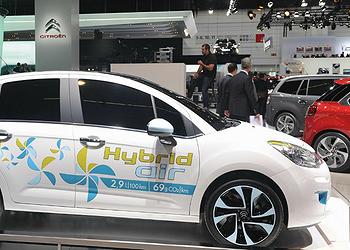
FRANKFURT, Germany, September 10, 2013 (ENS) – At the Frankfurt Motor Show the top subjects are electric mobility and vehicle connectivity as 159 world premieres and 1,091 exhibitors from 35 countries via for public attention.
Known in German as the Internationale Automobil-Ausstellung (International Automobile Exhibition, or IAA), this is the world’s largest motor show. It is held biennially in Frankfurt am Main, where it occupies 12 buildings.
Matthias Wissmann, president of the German Association of the Automotive Industry, Monday kicked off the first press day by proclaiming “huge progress” on cutting emissions of the greenhouse gas carbon dioxide (CO2).

“The progress achieved by the German automotive industry in reducing the classical pollutants, CO2 and fuel consumption is impressive,” said Wissmann.
“Measured against the year 2000, we have brought down particulate emissions by 94 percent. Our cars are therefore often cleaner than the ambient air!” he exclaimed.
For the so-called classical pollutants – volatile hydrocarbons, carbon monoxide, nitrogen oxides, and particulates – the new Euro-6 vehicles now have emissions that are reduced by 97 to 98 percent compared to levels at the beginning of the 1990s, he pointed out.
From 2006 to 2012, the newly registered passenger cars from German group brands made “huge progress” in fuel efficiency, he said, from 7.1 liters to travel 100 kilometres down to only 5.7 liters.
“At the same time,” Wissmann told reporters, “we drastically reduced CO2 emissions: from 175.2 grams per kilometer to 141.4 grams!”
The average fuel consumption by newly registered passenger cars from German makers fell to 5.5 liters for 100 kilometers – a drop of four percent compared with the same period last year.
Carbon dioxide (CO2) emissions from German-made vehicles have also continued to fall by four percent this year to 136.9 grams.
“Today we have 434 models on offer emitting less than 120 grams of CO2,” Wissmann said. “Our portfolio of these CO2 champions has expanded by almost 70 percent compared with last year!”
But these successes have been achieved by optimizing the clean diesels and petrol engines by using smaller engine capacities, fewer cylinders, turbocharging and lightweight construction, but Wissmann warned that these potentials for improvement are now nearly exhausted.
The 95 gram CO2 target planned for 2020 can only be achieved if a large number of electric cars are bought, he said.
The 95 gram target cannot be achieved with the internal combustion engine alone. This is the new quality that is the subject of the current debate on the CO2 Regulation.
We have drawn up a “path of innovations” for the IAA, he said, that shows the shortest route on the exhibition grounds to the latest innovations in environmental and climate protection, and offers information about electric mobility and connectivity.

Wissman said two strategically important innovation topics define this IAA – electric mobility and connected vehicles.
“The IAA shows that electric mobility is no longer a vision,” he said. Electric cars are on the roads as pure battery-electric cars, as plug-in hybrids, and as range extenders, and there are also fuel cell vehicles.
“So,” said Wissmann, “the IAA is throwing open the window to the future.”
The German manufacturers alone will launch 16 series models with electric drive onto the market by the end of next year.
The second focus of innovation is car connectivity.
In the coming years cars will become “mobile communication platforms,” Wissmann said.
Drivers will then be online all the time and connectivity will provide them with all the important information much faster than before. For example, the car will be able to “see further” than the driver ever could.
Connectivity enhances the safety of all road users, and for the driver it also means greater comfort, Wissmann said. “It is clear where this is heading: towards partially automated driving, and later to highly automated driving. These are fascinating prospects for motorists. And the market opportunities are enormous; we expect 36 percent growth per year.”
In 2016, 210 million connected cars will be on the world’s roads – four times as many as there are today, the German automotive industry organization projects.
Electric mobility and connectivity are visible at the exhibitors’ stands and will be covered in detail at two individual one-day symposia at the show.
The Frankfurt Motor Show opens to the public on September 12 and runs through September 22 at the Fairground of Messe Frankfurt.
Copyright Environment News Service (ENS) 2013. All rights reserved.
© 2013, Environment News Service. All rights reserved. Content may be quoted only with proper attribution and a direct link to the original article. Full reproduction is prohibited.
